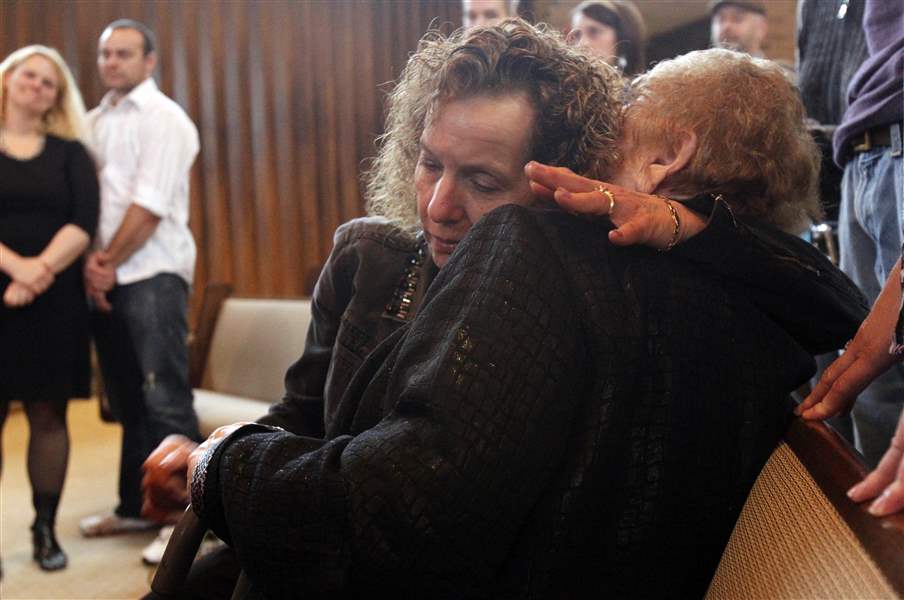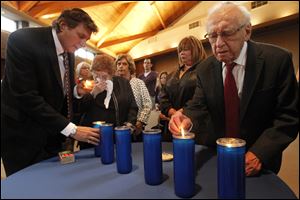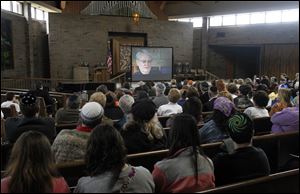
Film details trials of Toledo area Holocaust survivors
5/1/2011
Bella Wagner, left, hugs Clara Rona, a Holocaust survivor, after watching "Bearing Witness: The Voices of our Survivors," a documentary about six local Holocaust survivors during a Yom Hashoah, or Holocaust Remembrance Day event in the sanctuary of the Temple-Shomer Emunim at the Jewish Community Center.
The Blade/Amy E. Voigt
Buy This Image
Editor's note: This is the corrected of the Holocaust Remembrance Day article which ran in Monday's paper and was online prior to 8 a.m. Monday, May 2, 2011.

Bella Wagner, left, hugs Clara Rona, a Holocaust survivor, after watching "Bearing Witness: The Voices of our Survivors," a documentary about six local Holocaust survivors during a Yom Hashoah, or Holocaust Remembrance Day event in the sanctuary of the Temple-Shomer Emunim at the Jewish Community Center.
It has been 66 years since Auschwitz was liberated by Soviet troops, but for Jews who survived the horrors of that Nazi death camp the memories are as vivid as if they happened yesterday.
“We were dehumanized,” said Dr. Aron Wajskol .
“The conditions were indescribable,” said Philip Markowicz.
“You could smell burning flesh every day from the gas chambers.”
“If you fainted in line, the others would hold you up, because if you fell they would take you to the gas chambers,” said Clara Rona.
The stories of the three Holocaust survivors along with those of Rolf Hess, William Leons, and Abraham “Al” Negrin, all now living in the Toledo area, were told Sunday on Yom HaShoa, or Holocaust Remembrance Day, in the documentary Bearing Witness: The Voices of Our Survivors.
The film’s world premier and the Yom HaShoa program drew about 300 people to The Temple-Congregation Shomer Emunim in Sylvania.
The survivors then lit candles in a brief ceremony honoring and remembering the 6 million Jewish victims of the Holocaust, and local rabbis and cantors prayed and sang songs to mark the occasion.
The six local survivors in the movie, who range in age from 86 to 91, were filmed last year by Heather Elliott-Famularo and Dena Eber, both faculty members of the Bowling Green State University School of Art.

Tom Helberg, left, helps an emotional Clara Rona, a Holocaust survivor, light a candle with Dr. Aron Wajskol, also a Holocaust survivor, at the ceremony.
The 28 hours of interviews were trimmed into a 70-minute film that featured the elderly survivors responding to questions posed by 65 students in grades 7-12 from the Sunday Schools of three local synagogues.
Each question was presented by a succession of young faces deftly morphed into a sequence, their words strung together into a complete sentence. Among the questions were, “What was it like before the war?,” “What do you remember of the German invasion?,” and “What was it like in the camps?”
Miriam Shafransky, 12, of Sylvania, was one of the student interviewers whose face flashed on the screen – so briefly, in fact, that she missed it. But her mother, Ilise, and her friend, Samantha Walkin, 12, both spotted her.
The students met with each of the Holocaust survivors separately, and their questions were later filmed for the documentary.
“I think it was a really good thing for the kids to get involved. I read a couple of books about the Holocaust,” Miriam said. “I think it’s horrible that anybody could ever do something like that to another person.”
Samantha added, “I think it’s good that they show us what it was like.”
Mr. Markowicz, 86, also feels it is important that his and other survivors’ stories be preserved and passed on to future generations. He has written a biography, My Three Lives, describing his childhood in Poland, his World War II experiences, and his postwar life.
“We are all fading away,” he said. “It’s good that is has been caught on film. It’s not like reading it in a book. This is living history.”
Hindea Markowicz, his daughter-in-law and director of the Ruth Fajerman Markowicz Holocaust Resource Center of Greater Toledo, said in an introduction to the program that “those of us privileged to know survivors, as this community is … have a particular obligation to carry forward their legacy of remembrance, with its accompanying commitment to education and perpetration of their values.”
It was the Resource Center and the United Jewish Council of Greater Toledo that called upon the BGSU filmmakers to undertake the documentary.
“These students represent the last direct link to the Holocaust,” Mrs. Markowicz said, “able to pass their memories of this encounter on to their children, grandchildren, and even great-grandchildren, for them to tell their future generations.”

About 150 people watch a documentary about local Holocaust survivors during Yom HaShoah, or Holocaust Remembrance Day, at The Temple-Congregation Shomer Emunim.
The stories told in Bearing Witness were chilling, the audience sitting in rapt silence as survivors described the brutality of the Nazis and their systematic slaughter of 6 million Jews. They spoke of being rounded up and forced into overcrowded, disease-plagued ghettos; being jammed like sardines into railroad cattle cars and taken to the death camps.
Mr. Markowicz recalled when his train stopped briefly at a station and he reached his hand through a small opening. Someone put a bag in his hand -- it was a workman’s lunch.
He could scarcely believe that at time when “evil was all around,” someone would give his lunch to a total stranger who was locked inside a cattle car.
It fed his body and his spirit, he said, and restored his faith in humanity. “I thought, ‘The world is not totally going to pieces,’” Mr. Markowicz said.
Life in the camps was horrific, as survivors described being forced to do grueling work with little food or sleep. They would get a piece of bread and a bowl of soup -- with no utensils.
Mr. Leons was 4 1/2 and living in Rotterdam, Holland, when the Germans began bombing the city. He was excited at first, thinking it was a fireworks show.
The Nazis took his family away and he was rescued by a neighborhood family, hiding in an attic alone for up to 23 hours a day.
Mr. Hess, who was born in Frankfurt, Germany, in 1934, said he grew up experiencing “anti-Semitism at every level.”
Ms. Rona, 91, from Pecs, Hungary, said “everybody hated the Jews” in her village, and that “every week a new code” would be imposed on them by the Nazis.
Mr. Leons recalled seeing signs in stores that said, “Dogs and Jews prohibited from using facilities.”
Mr. Negrin said he assumed a fake Greek name and used a fake ID to hide the fact that he was Jewish.
Mr. Hess was sent to a home for children in France, and choked up on camera as he recalled going through a garbage can to eat apple peels tossed away guards.
Mr. Leons said he was reunited with his mother after the war. “I was so happy to see her,” he said, but added: “She came back a skeleton.”
Maggie Greenfield, 66, of Monroe, Mich., attended the Yom HaShoah event in memory of her Yugoslovian grandparents who were killed in the Holocaust.
“I came here to honor their memory – that they didn’t die for nothing,” she said.
The survivors were asked on film what their message was for others.
They all said it was to not stand idly by when injustice or evil is perpetrated by others.
“Nobody stood up and said it’s not right,” Ms. Rona said.
Contact David Yonke at:
dyonke@theblade.com
or 419-724-6154.